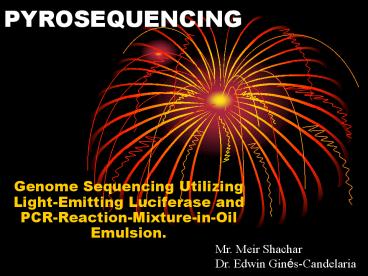PYROSEQUENCING - PowerPoint PPT Presentation
1 / 19
Title:
PYROSEQUENCING
Description:
PYROSEQUENCING Genome Sequencing Utilizing Light-Emitting Luciferase and PCR-Reaction-Mixture-in-Oil Emulsion. Mr. Meir Shachar Dr. Edwin Gin s-Candelaria – PowerPoint PPT presentation
Number of Views:3011
Avg rating:3.0/5.0
Title: PYROSEQUENCING
1
PYROSEQUENCING
- Genome Sequencing Utilizing Light-Emitting
Luciferase and PCR-Reaction-Mixture-in-Oil
Emulsion.
Mr. Meir Shachar Dr. Edwin Ginés-Candelaria
2
Introduction
- Read lengths are around 200-300 bases.
- 400,000 reads of parallel sequencing
- 100mb of output per run
- Run time 7.5 hours
Unless otherwise stated, read and output data
are provided on the 454 FLX 20 sequencer
3
Step 1 Preparation of the DNA
- DNA is fragmented by nebulization
- The DNA strands ends are made blunt with
appropriate enzymes - A and B adapters are ligated to the blunt
ends using DNA ligase - The strands are denatured using sodium hydroxide
to release the ssDNA template library (sstDNA).
4
The Adapters
- The A and B adapters are used as priming sites
for both amplification and sequencing since their
composition is known. - The B adapter contains a 5 biotin tag used for
mobilization. - The beads are magnetized and attract the biotin
in the B adaptors.
5
Filtering the Mess
- There are four adaptor combinations that are
formed from the ligation. - A---sequence---A
- A---sequence---B
- B---sequence---A
- B---sequence---B
6
Step 2 Cloning of the DNA (emPCR)
- Using water-in-oil emulsion, each ssDNA in the
library is hybridized onto a primer coated bead. - By limiting dilution, an environment is created
that allows each emulsion bead to have only one
ssDNA. - Each bead is then captured in a its own emulsion
micro-reactor, containing in it all the
ingredients needed for a PCR reaction. - PCR takes place in each of these beads
individually, but all in parallel. - This activity as a whole is emPCR.
7
Post emPCR
- The micro-reactors are broken, and the beads are
released. - Enrichment beads are added (containing biotin)
these attach to DNA rich beads only. - A magnetic field filters all DNA rich beads from
empty beads, and then extracts the biotin beads
from the DNA rich beads. - The DNA in the beads are denatured again using
sodium hydroxide, creating ssDNA rich beads ready
for sequencing.
8
Step 3 Sequencing
- Utilizing the A adapter, a primer is added to the
ssDNA. - The beads are now loaded into individual wells
created from finely packed and cut fiber-optics
(PicoTiterPlate device). - The size of the wells do not allow more than one
ssDNA bead to be loaded into a well. - Enzyme beads and packing beads are added. Enzyme
beads containing sulfurase and luciferase, and
packing beads used only to keep the DNA beads in
place. - Above the wells is a flow channel, passing
nucleotides and apyrase in a timed schedule.
9
PYROSEQUENCING
10
The Chemical Chain
- The nucleotide bases are added in a timed fashion
(beginning with A, T, G, C with 10s between each
nucleotide and a successive apyrase wash,
followed by the next nucleotide.) - As a bi-product of incorporation, DNA polymerase
releases a pyrophosphate molecule (PPi). - The sulfurylase enzyme converts the PPi into ATP
11
PYROSEQUENCING
12
The Fireworks Show
- Each ATP produced by sulfurilase is used by
luciferase. - Luciferase hydrolyzes each ATP molecule to
produce oxy-luciferin and light from the
substrate luciferin. - Luciferin ATP O2 ?(luciferase)?
- AMP oxy-luciferin PPi CO2 light
- A CCD camera records the light from the reaction.
- A wash of apyrase is released after each
nucleotide to remove the unincorporated
nucleotides.
13
PYROSEQUENCING
14
(No Transcript)
15
PYROSEQUENCING
16
Step 4 Data analysis
- The intensity of the light emitted by luciferase
is proportional to the number of nucleotides
incorporated. - Therefore, if the intensity of a single read is 3
times the intensity of a previous read, there are
3 times the amount of incorporated nucleotides in
the second read.
17
Two Types of Analysis
- Run Time Analysis
- Image acquisition raw image
- Image processing mapping of raw image to
corresponding wells - Signal processing the individual well signals
incorporated into a flowgram - Post-run Processing (separate computer)
- Assembly overlaps multiple reads to create
larger reads assembling a consensus read. - Mapping maps the reads onto the consensus
obtained from the assembly to re-sequence the
genome. - Amplicon Variant Analysis compares the sample
reads to referenced known sequences for
identification.
18
The Titanium model
- Read lengths of 400-600 base pairs.
- 400-600 million base pairs read per run.
- About 100 million parallel reads
19
Additional Links
- 454 life sciences
- www.454.com
- Detailed overview of the system
- http//www.454.com/products-solutions/multimedia-p
resentations.asp - Pyrosequencing animation
- http//www.youtube.com/watch?vbFNjxKHP8Jcfeature
related - http//www.pyrosequencing.com/DynPage.aspx?id7454
- Sequencing step animation
- http//www.youtube.com/watch?vkYAGFrbGl6E

